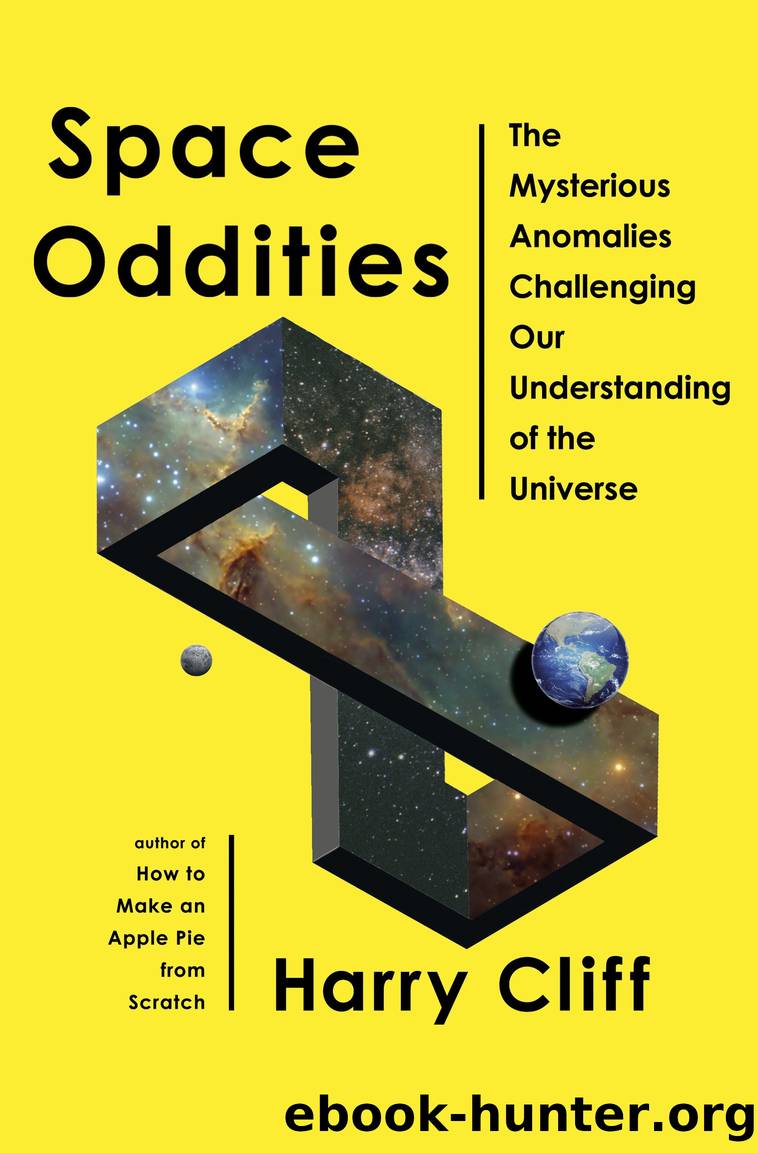Space Oddities by Harry Cliff

Author:Harry Cliff [Cliff, Harry]
Language: eng
Format: epub
Publisher: Knopf Doubleday Publishing Group
Published: 2024-03-26T00:00:00+00:00
Unexpected Guests
Deep within the sprawling Fermilab site, a side road runs through forest and shrubland to a small artificial hill. In one side of its grassy dome, a gray metal door marked âCautionâRadiation Controlled Areaâ opens into a chamber filled with racks of electronics and scattered with cardboard boxes of old computer kit. Though the space looks abandoned, the continuous roar of fans and pumps suggests that something is still going on beneath the hill. A trapdoor in the floor reveals what: a subterranean vault filled by a huge metal sphere, the three-story-high, eight-hundred-ton MiniBooNE detector.
Though now dormant, MiniBooNE[*3] remains a star character in an unfolding neutrino drama, one that promises to upend our understanding of natureâs most elusive building blocks. Inside the sphere are 250,000 gallons of ultrapure mineral oil surrounded by 1,280 amber orbsâlight detectorsâwhich once watched patiently for flashes of light in the dark liquid, a sign that a neutrino had made contact with an atom.
MiniBooNE sits on an invisible line that slices across the Fermilab site, starting at a target area about 550 meters to the south. Here, protons accelerated by the labâs fifteen-hundred-foot circumference âBoosterâ ring smash into a target with enough violence to break the mighty bonds holding their constituent quarks together, rupturing the protons into a spray of exotic particles. Among the subatomic shrapnel are the pions we discussed earlier, as well as kaons. Each is made from a quark and an antiquark glued together by the strong force. They are then magnetically funneled into a fifty-meter tunnel. As they fly through the empty space, they decay, transforming into muon neutrinos and their electrically charged muon cousins. Finally, a wall of steel and concrete absorbs everything except the neutrinos themselves, which whiz on unhindered, forming a beam that passes through steel, concrete, earth, and rock alike.
The purpose of MiniBooNE was to follow up on an anomaly found by a similar experiment, a thousand miles away at Los Alamos, New Mexico, in the late 1990s. The Liquid Scintillator Neutrino Detector (LSND) had seen something that was hard to explain using our current understanding of the science: muon neutrinos transforming into electron neutrinos over far shorter distances than was thought possible. As we saw earlier, neutrinos can indeed change their stripes as they travel. But such effects are usually only apparent once they have covered relatively large distances. LSND was positioned a mere thirty meters from a source of muon neutrinos; they shouldnât have had enough time to perform their Jekyll and Hyde transformation by the time they arrived at the detector. Nevertheless, despite starting off with an almost pure beam of muon neutrinos, the team at Los Alamos saw strong evidence that electron neutrinos were mysteriously appearing in their detector.
Their result suggested something potentially earth-shattering: the hidden influence of yet another, fourth type of neutrino. Weâve already met the three standard flavorsâelectron, muon, and tau. Many theories predict the existence of an even more intangible variety, a so-called sterile neutrino. We previously talked about
Download
This site does not store any files on its server. We only index and link to content provided by other sites. Please contact the content providers to delete copyright contents if any and email us, we'll remove relevant links or contents immediately.
| Aeronautics & Astronautics | Astronomy |
| Astrophysics & Space Science | Comets, Meteors & Asteroids |
| Cosmology | Mars |
| Solar System | Star-Gazing |
| Telescopes | UFOs |
Tools of Titans by Timothy Ferriss(8225)
Turbulence by E. J. Noyes(7942)
Secrets of Antigravity Propulsion: Tesla, UFOs, and Classified Aerospace Technology by Ph.D. Paul A. Laviolette(5311)
Astrophysics for People in a Hurry by Neil DeGrasse Tyson(5134)
Room 212 by Kate Stewart(5041)
Design of Trajectory Optimization Approach for Space Maneuver Vehicle Skip Entry Problems by Runqi Chai & Al Savvaris & Antonios Tsourdos & Senchun Chai(5012)
Pale Blue Dot by Carl Sagan(4917)
The David Icke Guide to the Global Conspiracy (and how to end it) by David Icke(4629)
A Journey Through Divination and Astronomy by Publishing Pottermore(4344)
Goodbye Paradise(3729)
Apollo 8 by Jeffrey Kluger(3638)
COSMOS by Carl Sagan(3559)
Losing the Nobel Prize by Brian Keating(3499)
The Five People You Meet in Heaven by Mitch Albom(3476)
How to Read Water: Clues and Patterns from Puddles to the Sea (Natural Navigation) by Tristan Gooley(3410)
Brief Answers to the Big Questions by Stephen Hawking(3369)
How to Read Nature by Tristan Gooley(3251)
The Order of Time by Carlo Rovelli(3145)
A Brief History of Time by Stephen Hawking(2962)
